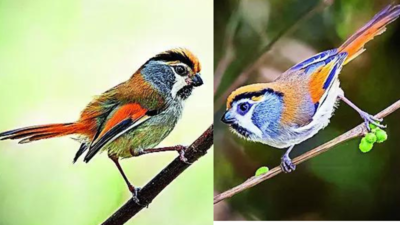- News
- City News
- guwahati News
- Trio from Assam sights rare black-throated parrotbill close to Cherrapunji in Meghalaya
Trending
Trio from Assam sights rare black-throated parrotbill close to Cherrapunji in Meghalaya
Doctors and a physiotherapist from Assam spotted the rare black-throated parrotbill in Meghalaya. Their sighting emphasizes the need for biodiversity conservation and the effects of climate change on bird species in the Himalayas.

The black-throated parrotbill, scientific name Suthora nipalensis, is a bird species found in the northern parts of the Indian subcontinent, mostly in the central and eastern Himalayas and nearby Southeast Asia
GUWAHATI: Two doctors and a physiotherapist from Assam, who are also bird enthusiasts, have sighted the rare black-throated parrotbill in Meghalaya. This recorded sighting happened close to Cherrapunji, once known as the world’s wettest place and also a popular destination for tourists.
The trio — Dr Jyotirmay Baishya, a plastic surgeon, Dr Manas Kumar Kalita, a dental surgeon, and Rocky Srivastava, a physiotherapist — were thrilled by their sighting of the black-throated parrotbill, which was not recorded for over 170 years in Meghalaya.The trio captured the bird on camera in an undergrowth of the subtropical moist broadleaf forest with a few bamboo patches near Sohra (Cherrapunji) of the hill state. Their finding was reported to 'ebird' — an international platform for maintaining records regarding sightings, habitats, population and other important information about birds on this planet.
According to the three doctor-birders, 10 birds of this species were seen foraging for food. Their tiny size, small parrot-like bill, distinctive black throat patch and vibrant plumage helped in their identification.
The black-throated parrotbill, scientific name Suthora nipalensis, is a bird species found in the northern parts of the Indian subcontinent, mostly in the central and eastern Himalayas and nearby Southeast Asia. There are several subspecies of this bird. The last specimen-based sighting was reported from Meghalaya in 1851 by an English zoologist and ornithologist, Edward Blyth. Although this subspecies sighted has its historical distribution from eastern Himalaya to the south of Manipur and parts of Meghalaya, no sighting has been reported in Meghalaya since Blyth’s record.
The trio — Dr Jyotirmay Baishya, a plastic surgeon, Dr Manas Kumar Kalita, a dental surgeon, and Rocky Srivastava, a physiotherapist — were thrilled by their sighting of the black-throated parrotbill, which was not recorded for over 170 years in Meghalaya.The trio captured the bird on camera in an undergrowth of the subtropical moist broadleaf forest with a few bamboo patches near Sohra (Cherrapunji) of the hill state. Their finding was reported to 'ebird' — an international platform for maintaining records regarding sightings, habitats, population and other important information about birds on this planet.
According to the three doctor-birders, 10 birds of this species were seen foraging for food. Their tiny size, small parrot-like bill, distinctive black throat patch and vibrant plumage helped in their identification.
The black-throated parrotbill, scientific name Suthora nipalensis, is a bird species found in the northern parts of the Indian subcontinent, mostly in the central and eastern Himalayas and nearby Southeast Asia. There are several subspecies of this bird. The last specimen-based sighting was reported from Meghalaya in 1851 by an English zoologist and ornithologist, Edward Blyth. Although this subspecies sighted has its historical distribution from eastern Himalaya to the south of Manipur and parts of Meghalaya, no sighting has been reported in Meghalaya since Blyth’s record.
On their sighting, Dr Baishya said, “This sighting is not just a personal achievement but also a call to action for conservation efforts in the region.”. Dr Kalita added, “The subspecies of the black-throated parrotbill found in Meghalaya has a reddish-brown head and back of the neck, with a grey face patch and body. It looked like the Suthora nipalensis poliotis subspecies. The sighting has significant implications for the conservation of this species specifically in Meghalaya. This observation will contribute valuable data to the global birding community, helping researchers and conservationists better understand the parrotbill’s behaviour, habitat and population dynamics.” Srivastava said that this shrinkage in the distribution map may be because of climate change, habitat loss and the practice of hunting. “The black-throated parrotbill sighting in Meghalaya is a reminder of the region’s rich biodiversity and the importance of preserving our natural heritage,” he said.
End of Article
FOLLOW US ON SOCIAL MEDIA











